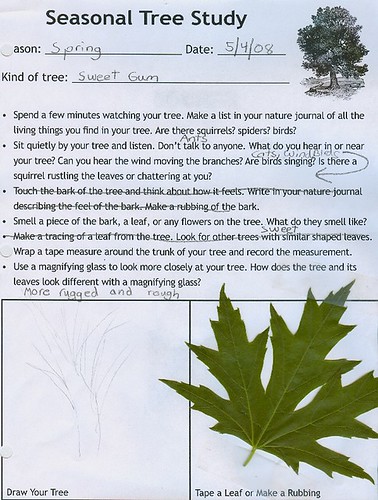Only the growing and open season is thought to be attractive in the country. The winter is bare and cheerless. A tree is weeping, gay, restful, spirited, quiet, sombre. That is, trees have expression. The expression resides in the observer, however, not in the tree. Therefore, the more the person is trained to observe and to reflect, the more sensitive his mind to the things about him, and the more meaning the trees have. No one loves nature who does not love trees. - L.H. Bailey, 1899We have done year-long tree studies before and it is a great way to learn about a tree, to become familiar with its life cycle through the seasons. Taking a year to get to know a tree allows you to focus on a different part of the tree in each season. A year-long tree study can be as simple as making observations in each season and talking about what you see as the tree changes or transforms. Or, you can make it more in-depth by adding in additional reading in the Handbook of Nature Study and keeping a nature journal of your observations.
"Children should also become familiar with trees at an early age. They should pick about six in the winter when the leaves are gone, perhaps an elm, a maple, a beech, etc, and watch them during the year."
Charlotte Mason, volume 1 page 52
I invite you to join our family by picking a tree in your yard or neighborhood and watching it through each of the coming seasons for the next year. Charlotte Mason suggests starting this project in the winter but our family has successfully enjoyed starting our tree study in the summer or fall.
Here is a recap of ideas for your Year-Long Tree Study.
 |
| Notebook Page from the More Nature Study #4 Summer Sizzle Ebook |
1. Sight: Look closely at the bark and leaves. Stand or lay under your tree and look up. Use a magnifying lens to look at the bark and leaves. Look for birds, animals, or insects in your tree. Look for all the parts of your tree: trunk, crown, branches, and spray.
2. Smell: Smell the bark. Rub a leaf and see what it smells like.
3. Touch: Close your eyes and feel the bark. Feel the leaf or needle from your tree and describe its texture.
4. Hearing: Quietly sit under your tree for one minute. Can you hear the leaves or branches moving? Can you hear a bird in the tree or insects buzzing near the tree?
5. Taste: If your tree has fruit, you can choose to taste the fruit.
Simple Suggestions for an Autumn Tree Study:
Compare Leaves from Two Different Trees
-Leaf shape and leaf margins.
-Leaf arrangement on the stem.
-Leaf color, texture, and size. (You can measure if you wish.)
You can take photos of your tree to put in your nature journal or you can sketch the tree in your journal.
Simple Suggestions for Winter Tree Study:
1. Pick a tree in your yard or on your street and view its branch patterns and silhouette.
2. Find a tree that has lost its leaves and sketch its shape in your nature journal. This activity can be done from a window if your weather is too cold or snowy.
3. Collect some seeds from trees that may still be left over from last season. Look for sweet gum, locust, yellow poplar, ash, mimosa, or sycamore.
4. Collect twigs from different trees and compare them.
Simple Suggestions for Spring Tree Study:
1. Pick a tree in your yard or on your street and look for its new leaves and blossoms if appropriate.
2. Is it just beginning to show leaves? Can you tell if your tree has all of its leaves yet?
3. Can you see any insects or birds in your tree?
4. Collect a few leaves to use for leaf rubbings in your nature journal. You could also make a leaf bouquet.
5. Compare two leaves from the same tree. Are they exactly alike?
6. Use your nature journal to record a sketch of the leaf and any blossoms.
7. How has the tree changed since autumn? Winter?

Free Seasonal Tree Notebook Page
Handbook of Nature Study- Tree Study Using the Outdoor Hour Challenge


Man, I am never going to catch up. You keep posting *fantastic* ideas for nature studies. And I print them. And hope to get started on some of them in the fall. I need a file folder for all the great nature ideas you give me.
ReplyDeleteThank you for all you do.
Cristy,
ReplyDeleteI think once summer is over I am just going to start using the ideas from the newsletters and recycling old posts as the basis for the OHC. Stay tuned for a new look in the fall. :)
Don't try to catch up....just keep looking for opportunities to take advantage of things that come up and then check my archives if you need help getting started.
You are doing a great job!
Thanks, Barb. I appreciate your encouragement. I will try to concentrate not on "catching up," but on taking advantage of opportunities that come up.
ReplyDeleteSuper-great ideas!
ReplyDeleteMy recently turned 5yo and I have been photographing our elm tree each month since Jan. to see the changes. I think we might have it try some of these things.
Thanks for sharing.